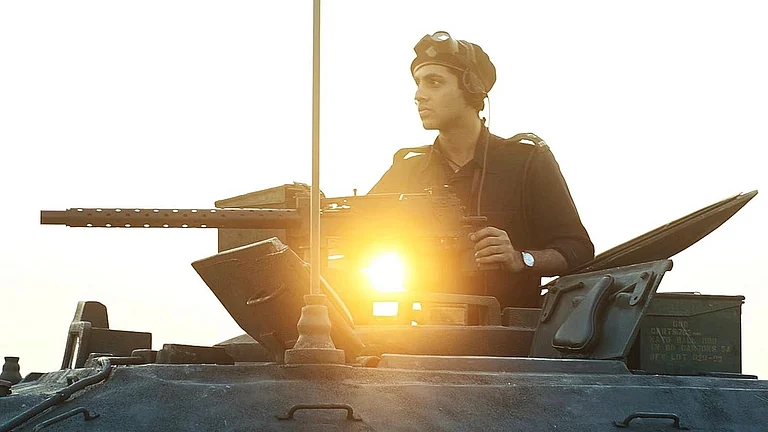A young, educated woman who had lived with her husband in China until a year ago, occupies one of the plastic chairs outside the office of Sanjay More, shahar pramukh (city chief) of the Shiv Sena in Pune. The woman, a mother of a six-month old, says she is a victim of domestic violence. Finding no redressal at the local police station, she knocked on the doors of the Nana Peth shakha (unit) of the Shiv Sena, for a solution to her domestic matter.
More listened intently and then called a female sainik to take up the woman’s case. “Why do you take his beatings,” is her opening line. “Have you got no hands? Throw some mirchi (chilli) powder into his eyes and he will never touch you again,” is the sainik’s solution to the problem. More interjected, saying that the woman wanted to go back to her marital home. The sainik stands up, assuring More that the woman would be taken to her home later that evening. “Let me then see who throws her out,” says the female sainik and walks out of the room with the victim in tow.
There are many more waiting outside the door. They seek admissions to colleges, beds in hospitals, redressal of salary issues, discounts from builders for houses, respite from alcoholic husbands indulging in domestic violence, relief from rowdies and eve teasing, employment, and much more. “I know my problem will be solved at this shakha,” says a man waiting for an audience with More. “I have not approached any government person for my problem. A phone call or a letter from More saheb will ensure that my problem is solved,” said the man.

At every shakha in Maharashtra, the issues of women and senior citizens are addressed first—a diktat Bal Thackeray—founder of Shiv Sena—made mandatory. Those in the know of events observe that over the years, shakhas have grown in number, though the number of Shiv Sainiks has dwindled. Anyone who wants to set up a shakha can do so and even anoint themselves as the shakha pramukh. “Balasaheb believed that only someone motivated by Shiv Sena’s ideology will start a shakha. So, there was the freedom to do that,” said Ashutosh Mokashi, a senior Shiv Sainik. “Every shakha has people coming in through the day for redressal of their grievances,” said Mokashi.
The Shiv Sena started out as an organisation in 1960, when Bal Thackeray—a cartoonist by profession—started Marmik, a magazine in Marathi. This magazine was inaugurated by Yashwantrao Chavan, the then chief minister of Maharashtra. Back then, there was a Congress government in Maharashtra, and Thackeray had an amicable relationship with its party leaders. Through Marmik, Thackeray started taking on various issues that affected the Marathi manoos or ‘the sons of the soil’. On the sidelines, the Shiv Sena was taking shape as an organisation. In time, anti-establishment agitations or ‘tod-phod agitations’ became central to the Sena. Thackeray’s aggressive posturing started drawing in the youth. For several years, the organisation was centred in Mumbai. Slowly, Thackeray encouraged its growth in neighbouring Pune, which is closely linked to the history of the Maratha warrior king Chhatrapati Shivaji. According to a sainik who has been with Thackeray since the inception of Shiv Sena, the weaving of the Maratha ruler’s mythology into the Sena’s ideology came in much later as the organisation evolved.
ALSO READ: Unfailing Commitment Of CPI(M) Red Brigades
It was Bal Thackeray’s father Keshav who pushed him into turning Shiv Sena into a political outfit. On June 19, 1966, the Shiv Sena became a political organisation. Talking about this transition, Pandharinath Sawant, 87, an associate of Thackeray, says, “We were sitting in a room in Dadar, when suddenly Balasaheb asked someone to bring a coconut. He broke it on the floor and that was the start of the Shiv Sena’s political journey. If Balasaheb sneezed in his house, half of Mumbai would catch a cold. That was the power of the man,” Sawant reminisces.

A cadre-based party, the Sena has a strict hierarchical system. The shakha pramukh is at the lowest rung of the ladder. The upward hierarchy includes: upa vibhag pramukh, vibhag pramukh, upa shahar pramukh, shahar pramukh, sampark mantri, upa neta and neta. The senior leaders of the party report directly to the Shiv Sena chief. Old timers recall that Thackeray gave much importance to shakhas as they worked directly at the grassroots. For the sake of effective administration of its shakhas, every district in Maharashtra had two parts—shahar (urban) and zilla (rural). As per a senior sainik, powerful leaders emerged through agitational politics at the grassroots. “Those days, we did not have to take permission for agitations. Every sainik believed that unless there was tod phod no one listened to you. Balasaheb’s powerful oratory and style of functioning drew in the youth. Entire cadres of the CPI and the CPI(M) joined the Shiv Sena,” says a senior sainik to Outlook.
Though many Marathi women were drawn to the Shiv Sena, the violent agitations kept them away. It is only after Meenatai, wife of Thackeray, started touring along with her husband, did the strength of women sainiks see an increase, said Rambhau Parikh (65), who has been a Shiv Sainik for the past 55 years. “The Shiv Sena has to go back to agitational politics if it has to survive. Power in the state has mellowed us and the cadres are itching for action. Sainiks are not people who will sit on the sidelines. We need action,” said Parikh, who is an acid attack survivor. The left side of his face, a damaged left eye and ear lobe bear the scars of the attack that took place due to political rivalry.
Ganesh Phadke, 47, joined the Sena when he was 10 years old. His family members tried to dissuade him from becoming a sainik. In later years, his father supported his decision, but there were regular disagreements with his mother on the subject. “Shiv Sena then and now is very different. I belong to Balasaheb’s Shiv Sena, when it was an organisation, and agitational politics was our strength. Now it is a party, and you see the difference,” says Phadke, who took to driving a tempo after huge losses in his business. “We were lauded for the agitations we did. We did not have to ask anyone. It is not the same now. We are chided if we agitate. In case we do, an order is drawn up and sent from Mumbai,” he tells Outlook.

Cutting across rural and urban areas, the Shiv Sainiks that Outlook spoke to were unanimous about the party losing out on the cadre due to the moderation that had set in. “Today, the Shiv Sena is about money. Only those with money can rise. Loyalty is not a factor any more. Sainiks at the lower levels do not know what to do. We will never leave the Sena. We are forced to sit quietly as Uddhav’s Sena is not Balasaheb’s Sena,” said a senior sainik from Mumbai. There is a clear divide between those who owe their loyalties to Balasaheb—who passed away on November 17, 2012—and Uddhav, his son and present-day party chief who is also the Maharashtra chief minister. Old timers strongly believe that Uddhav must travel across the state, re-establish links with the cadre and inject aggression into them. “Today, instead of tod phod, we are handing out memorandums. The cadre is getting disillusioned,” says a concerned sainik.
Every old timer that Outlook approached, spoke about the party’s golden era that spanned from the 1980s to 1995—the year when the party came to power in Maharashtra for the first time. “The downslide of the cadre started after the Shiv Sena installed its chief minister at Mantralaya. Agitations became sporadic. With Uddhavji and Aaditya, agitations have completely stopped. It is very difficult to meet our leaders in Mumbai. This lack of accessibility is hampering the party’s growth,” says another sainik. The Shiv Sena of the past boasted of one of the quickest message transmission services at a time when there were only landlines. “We either had a landline in the shakhas or in shops close to the shakhas. Any message from Balasaheb was communicated to us quickly. Within half an hour, every shakha in Maharashtra would put out blackboards announcing Balasaheb’s message. Not anymore,” said Ashutosh Mokashi, a sainik. Most of those who joined the party confess they were attracted to Balasaheb’s personality.

The present-day Shiv Sena is caught between the old and the new. There is a marked difference between Balasaheb’s Sena and Uddhav’s Sena. The new Sena, the one that has emerged as a ruler from being the rebel, is fighting for acceptability amongst its cadre. The father-son duo of Uddhav and Aaditya are transforming the once belligerent and violence-loving party into a moderate one to suit the current political environment. The party cadre, though, are unhappy at being denied their regular adrenaline rush of tod phod.
(This appeared in the print edition as "How Far Will the Tamed Beast Go?")
ALSO READ
Haima Despande in Mumbai & Pune


























